

?tag=nl. Augmented and virtual reality have been embraced by the gaming world, but can these technologies really be useful in business?

Respondents to the latest Tech Pro Research survey think so. Virtual Worlds Best Practices in Education. Use Storybricks to Create Stories in Virtual Worlds. eSchool News Augmented reality snags a coveted spot in classrooms. Increased accessibility, applications mean augmented reality is no longer a pipe dream Courtesy of The Teaching Palette.

A student holds a tablet in front of a series of famous paintings. On each painting, something comes to life–sounds, animation, or a pop-up fact linking the painting to historical events. The scene is reminiscent of a Harry Potter movie, but this isn’t magic. This is augmented reality–which, due in part to an increase in access to mobile devices and augmented reality apps, is becoming increasingly common in K-12 classrooms. Augmented reality uses technology to blend the real world with interactive and enhanced content. Bonding with avatar can shift perception. PENN STATE / U.
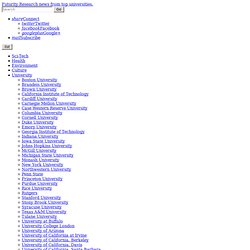
MICHIGAN (US) — People who customized an avatar and saw it wearing a backpack overestimated the heights of virtual hills, just as people in real life tend to overestimate heights and distances while carrying extra weight. “You exert more of your agency through an avatar when you design it yourself,” says S. Shyam Sundar, professor of communications and co-director of the Media Effects Research Laboratory at Penn State, who worked with University of Michigan doctoral student Sangseok You.
“Your identity mixes in with the identity of that avatar and, as a result, your visual perception of the virtual environment is colored by the physical resources of your avatar.” Researchers assigned random avatars to one group of participants, but allowed another group to customize their avatars. “If your avatar is carrying a backpack, you feel like you are going to have trouble climbing that hill, but this only happens when you customize the avatar,” says Sundar.
Source: Penn State. Once an edupunk, always an edupunk. What do you do when you have no training budget?
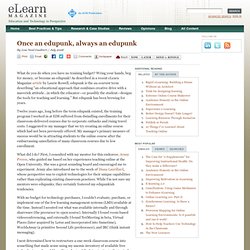
Wring your hands, beg for money, or become an edupunk! As described in a recent eLearn Magazine article by Laurie Rowell, edupunk is the au courant term describing "an educational approach that combines creative drive with a maverick attitude…in which the educator—or possibly the student—designs the tools for teaching and learning. " But edupunk has been brewing for years. Twelve years ago, long before the term edupunk existed, the training program I worked in at EDS suffered from dwindling enrollments for their classroom-delivered courses due to corporate cutbacks and rising travel costs.
I suggested to my manager that we try creating an online course which had not been previously offered. What did I do? With no budget for technology purchases, I couldn't evaluate, purchase, or implement one of the few learning management systems (LMS) available at the time. The World is Open for a Reason. The educational world has become filled with millions of pieces of free and open content.
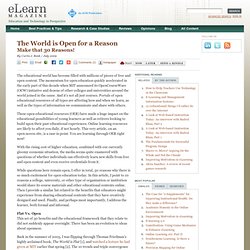
The momentum for open education quickly accelerated in the early part of this decade when MIT announced its OpenCourseWare (OCW) initiative and dozens of other colleges and universities around the world joined in the cause. And it's not all just courses. Another life. Are virtual worlds a breakthrough technology that will forever reshape learning and business?
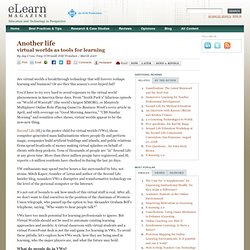
Or are they this season's over-hyped fad? You'd have to try very hard to avoid exposure to the virtual world phenomenon in America these days. From "South Park's" hilarious episode on "World of Warcraft" (the world's largest MMORG, or Massively Multiplayer Online Role-Playing Game) to Business Week's cover article in April, and with coverage on "Good Morning America," "CBS Sunday Morning" and countless other shows, virtual worlds appear to be the new-new thing. Immersive Learning for Teacher Professional Development. One of the most emergent and rapidly mutating forms of online and computer-based learning is "immersive environments.
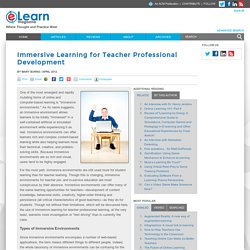
" As its name suggests, an immersive environment allows learners to be totally "immersed" in a self-contained artificial or simulated environment while experiencing it as real. Immersive environments can offer learners rich and complex content-based learning while also helping learners hone their technical, creative, and problem-solving skills. Because immersive environments are so rich and visual, users tend to be highly engaged.
Knowledge Transfer from Virtual Environments. Trainees of high-stakes scenarios, such as firefighting drills, pilot training, and search-and-rescue exercises, benefit wildly from simulation technology and virtual environments.
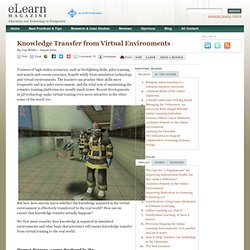
The learners can practice their skills more frequently and in a safer environment, and the total cost of maintaining the complex training platforms are usually much lower. Recent developments in 3D technology make virtual training even more attractive in the other sense of the word, too. But how does anyone know whether the knowledge acquired in the virtual environment is effectively transferred to the real world? How can we ensure that knowledge transfer actually happens? We first must consider how knowledge is acquired in simulated environments and what basic characteristics will ensure knowledge transfer from virtual training to the real world.
Augmented Reality: A new way of augmented learning. Augmented learning is defined as an on-demand learning technique where the learning environment adapts to the needs and inputs from learners [1].
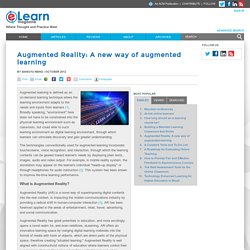
Broadly speaking, "environment" here does not have to be constrained into the physical learning environment such as classroom, but could refer to such learning environment as digital learning environment, through which learners can stimulate discovery and gain greater understanding. The technologies conventionally used for augmented learning incorporate touchscreens, voice recognition, and interaction, through which the learning contents can be geared toward learner's needs by displaying plain texts, images, audio and video output. For example, in mobile reality system, the annotation may appear on the learner's individual "heads-up display" or through headphones for audio instruction [2].
This system has been shown to improve life-time learning performance. The Universal Campus: An open virtual 3-D world infrastructure for research and education. We are at the beginning of a major information technology trend to develop increasingly complex 3-D virtual worlds and immersive virtual realities, and to expand the Web from 2-D to 3-D.

In the 3-D Web broadly construed, users can interact, collaborate, and conduct transactions in different virtual worlds accessible through a Web browser or some other interface. While the 2-D Web experience has remained somewhat private, the 3-D virtual world experience is inherently community oriented. Beginnings of this major trend are seen of course in computer games and sharable simulated virtual worlds, such as Second Life. The 3-D Web is poised to profoundly change how we interact, socialize, conduct business, and play.
Virtual worlds, real tasks. Educators have started recognizing that video games will play a significant role in the future of learning. Online games are the new playground for children and teenagers, and present unique opportunities for rich online learning environments. However, addiction to online games causes educational and social problems for which teachers, parents, and researchers are seeking solutions. And those who create online games bear some responsibility for participants' well-being. I'd like to suggest channeling negative addiction patterns into positive energy by integrating virtual mixed-reality tasks—which can involve real-world community service—into online games. The Prevalence of MMORPG MMORPG stands for massive multiplayer online role-playing games.
A survey conducted in October 2007 showed that 88.2% of kids age 11 to 14 in Taiwan play online games on a regular basis. Control Won't Work In 2005, China introduced a system meant to thwart online game addiction. Are Virtual Worlds (still) Relevant in Education? This is the question that was posed to me when I was invited to write this article for eLearn magazine. Having been involved in the effort to leverage virtual worlds (VWs) in education since the early days, I think I've seen the idea run the gamut of reactions. From early unknowns, to excitement, to evangelism and early adopters, and to today's somewhat jaded and cautious reactions, VWs in education have been on the rollercoaster of Gartner's Hype Cycle. Back in 2005, the growth of Second Life (SL), which was the first social virtual world without overt MMORPG game mechanics, seemed to herald the age of educational virtual world use.
SL got the attention of educators because it wasn't a "game" and allowed users to build environments and programmed objects along with social interaction. Sudden increased awareness of the platform served as a "Technology Trigger" that had instructional technologists and educators clamoring to collaborate on ways to utilize this new tool. The Economy. ELI7015.pdf (application/pdf Object) Seriousvirtualworldsv1.pdf (application/pdf Object) Home - Learning in 3D. BestTeachingPracticesforVWs.pdf (application/pdf Object) Learning in a Virtual World: Experience With Using Second Life for Medical Education. Introduction Background Virtual worlds are rapidly becoming part of the educational technology landscape. Forterra’s OLIVE, The Croquet Consortium, Sun Microsystem’s Project Wonderland, ProtonMedia’s Protosphere, and Linden Lab’s Second Life are all examples of virtual world environments []. Platforms like these are potential environments for providing medical education.
Untitled. Virtual worlds among latest trends in language education. Immersive environments can reduce student stress, increase engagement. OTL Newsletter» 2008 (01) January/February » Second Life: Using Virtual Worlds for Instruction and Learning. Author: Anne-Marie Armstrong Friends meet You may have seen articles about a new technology called Second Life in the Chronicle of Higher Education or other academic publications, but are unsure of what it is.
Second Life is a multi-user virtual world, created by its users, that has a global population of over 8 million. To participate in Second Life, you create an avatar (a 3-D image representing you in your “Second Life”) that can walk, talk, gesture, fly and talk with others. Cardio emergency simulation Some predict that Second Life is the new teaching tool for colleges and universities. The Power of Virtual Worlds in Education_0708.pdf (application/pdf Object) Pennsylvania Elementary School Launches Class-Sized Immersive Simulator.